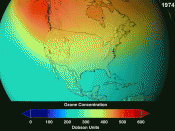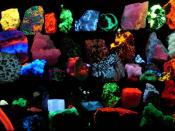The Potential Effects of a Depleted Ozone Layer
' And God said, let there be light and there was light and then God saw the light, that
it was good ' ( Genesis 1: 3-4 ). Undoubtedly, light is good. Without light man could not
survive. Light is the ultimate cosmic force in this universe allowing man to progress and
flourish. In the form of heat, light from the sun warms the Earth. Light, also, is the single
most important factor influencing the growth and development of plants. Photosynthesis, a
process by which plants incorporate light from the sun, allow plants to botanically grow
and survive. Certain forms of light are harmful and thus can be said are 'bad'. A natural
umbrella called the ozone layer protects the Earth and its inhabitants by screening out this
harmful light. For ' millions of years ozone has been protecting the earth ' by absorbing
ultraviolet or bad radiation from the sun ( Rowland, 1992, p.66
). This natural umbrella
protecting mankind has recently suffered the effects of industrialized society. This ' ozone
shield is dissipating ' and the cause is laid primarily to man - made chemicals
( Bowermaster et al, 1990, p.27 ). If enough of these man - made chemicals are released,
' the ozone layer would be weakened to such an extent that it does not filter out the sun's
invisible and dangerous ultraviolet rays ' ( Jones, 1992, p.36 ). Such a scenario would
drastically alter society and the environment. Ozone depletion has been described as
' potential catastrophe ' and ' a planetary time - bomb ' ( Way, 1988, p.9 ). The four main
areas affected by a depleted ozone layer and thus by the corresponding increase in harmful
ultraviolet radiation are agriculture, wildlife, the environment,


